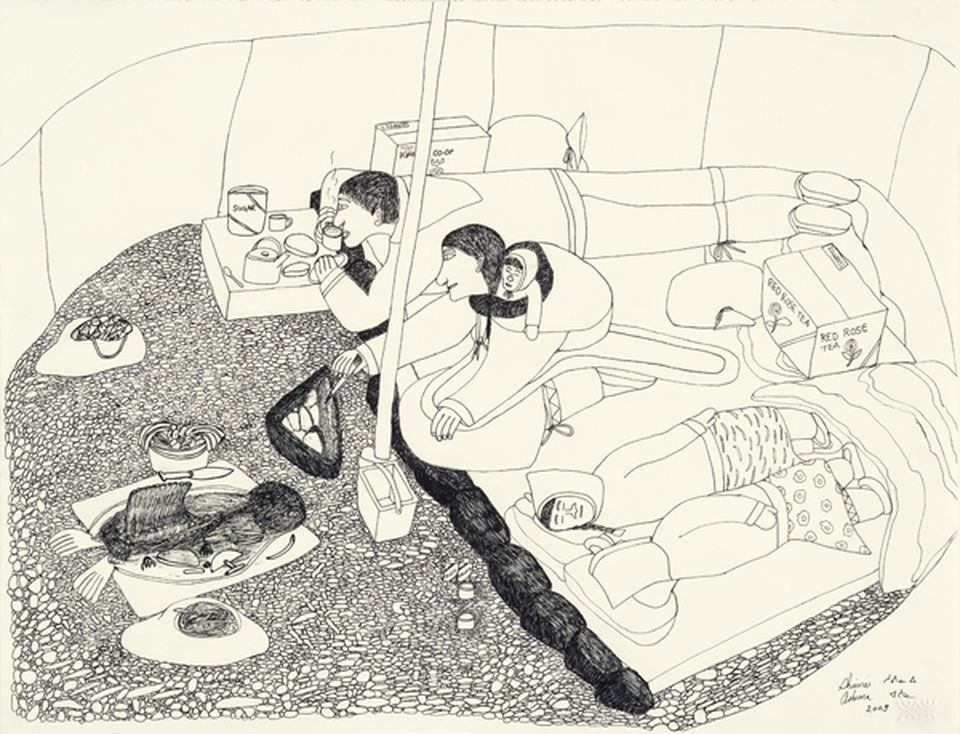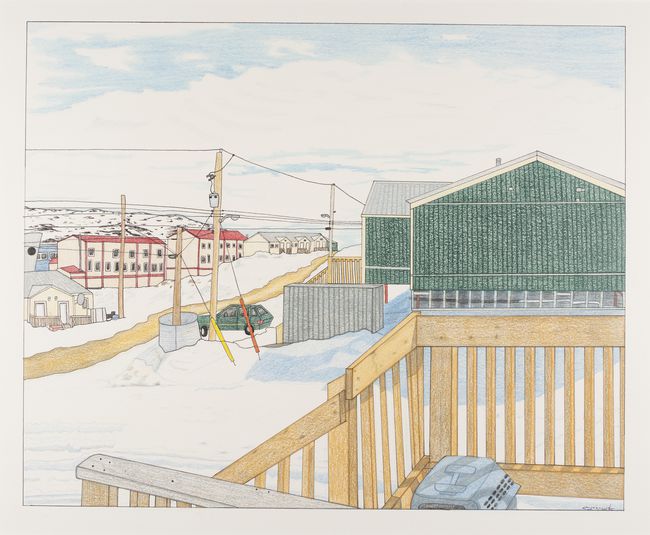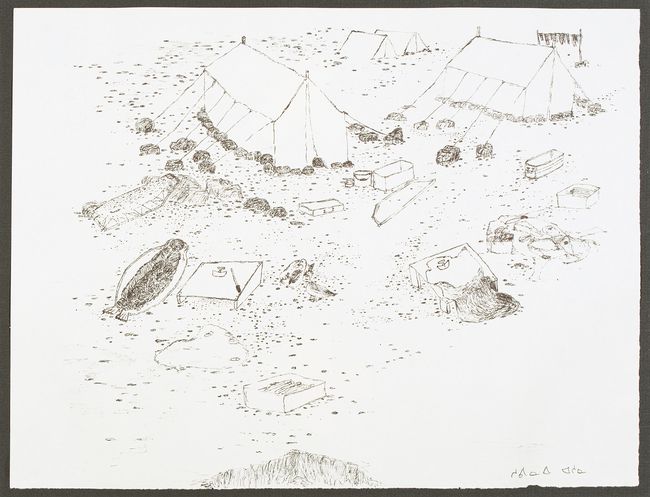ᐃᓄᐃᑦ ᓯᕗᓂᒃᓴᒧᑦ ᑐᕋᖓᔪᖅ
Jocelyn Piirainen speaks with Rafico Ruiz about Inuit futurism, institutions, and being an urban Inuk
ᐊᖏᕐᕋᒧᑦ / Ruovttu Guvlui / Towards Home was co-curated by Joar Nango, Taqralik Partridge, Jocelyn Piirainen, and Rafico Ruiz, with Ella den Elzen as Curatorial Assistant. We have also published talks featuring Nango and Partridge. The exhibition is currently on view in our Main Galleries and runs until 12 February 2023.
- RR
- What does angirramut (ᐊᖏᕐᕋᒧᑦ) mean for you? Is it about being grounded in home, or is there some movement or progression into the future implied in towards home?
- JP
- I’m still very much learning and relearning Inuktitut—and even my own dialect, Inuinnaqtun—but it has a very layered meaning, I think, angirramut. It’s a really beautiful translation. There is some sense that it means moving somewhere. You’re going forward, at least—or really, towards, you’re going towards something, going into the future.
- RR
- Beyond having written about Inuit futurism in Canadian Art, you also curate at Qaumajuq, the Inuit art centre at the Winnipeg Art Gallery, and are really involved in supporting and furthering Inuit art. I wonder—and I’m sure it’s hard to generalize—how different members of the Inuit community engage with Qaumajuq. Is it a centre for art? Or for Inuit culture? Is the word art an adequate term for it or do you see other terms that are better suited?
- JP
- That’s a good question. It’s interesting: in Inuktitut, there’s no specific translation for the word art. There are a few different words with different meanings. One of the most prominent is about the idea of making something, which, really, is what art is: somebody is just making something. It’s the same with the word architecture: it’s about someone creating structures. The exhibition shows some of these interesting intersections between art and architecture. You get different perspectives from artists and makers working with different media on the future for building in the North and for Indigenous architecture.
- RR
- Approaching this from a very different angle—I’m thinking maybe more historically, in terms of the histories of settler colonialism in what’s now Nunavut, and about the introduction of art as a sort of settler technique of control in a way—I wonder: why do you think contemporary Inuit and Sámi artists are having such a profound influence on spacemaking in the design world more generally?
- JP
- Well, going back to the last question around Qaumajuq and what it means for Inuit, I feel that, in designing these kind of bigger art institutions, you do want to have the community’s input, but then you also want to go in with the idea that these new buildings will be safe spaces for the community. The next generation of Indigenous architects is asking themselves these questions: Is what you’re creating really a safe space? Is it a place that Inuit and other Indigenous folks can call home? Can they feel at home there?
With Qaumajuq, Inuit did get a comfortable space, with the building’s glass wall and glass vault opening the Inuit art collection to not only the Inuit community but to everybody. It’s very welcoming. You want to go in and see what’s there.
Artists can also offer different perspectives. Maybe a little bit more creativity than architects [laughs]. But again, it’s about these different perspectives, coming from many different people, which are beneficial for the future for building in the North.
You really have to talk to the community about what it is they do need, and about how you then go about that. If you’re building an entirely new hospital or nursing station up North, obviously you want to speak to health practitioners there and see what they would want, but then you would also want to talk to a lot of the elders as well. Elders are such a big part of both Indigenous and specifically Inuit culture too. There’s so much knowledge there with them, and elders nowadays have lived through so much change. They’re incredibly resourceful that way, to have adapted to so many of these changes. Their knowledge is priceless. - RR
- I was reading—and you would of course be much more aware of it—about the lack of elders’ long-term care spots in Nunavut specifically; so many elders have to leave their homes and go to Ottawa for long-term care. It’s a great example of where investing in an Inuit-led definition of architecture could help to resolve that situation. For Southerners, it always means building a hospital, right? But it’s actually not the physical structure that matters so much as finding different ways of supporting the community.
- JP
- Long-term care for elders is an idea that does come from the South; historically, we would have taken care of our elders, of course—I mean, we still do, but it’s just in a different way that I don’t think people down South quite understand yet. Still, it isn’t until you talk to the community that you see what they need.
- RR
- I also wanted to ask why you chose the series of drawings that appear in the porch space of the exhibition. You’re really the strong curatorial voice there, so I wonder, what guided your selection?
- JP
- When I started looking through our collection, I was surprised that we didn’t have a whole lot that related to architecture or even structures. I know the artwork exists: it’s out there. Contemporary Inuit artists have been making precise drawings of typical Northern buildings, and they’re really beautiful. There’s one piece by Itee Pootoogook of an abandoned, broken-down building, and the way it’s drawn is just visually striking. In the collection, there were a lot of pieces that related more to family activities within the home, so I included a couple of those—a nice Shuvinai Ashoona piece of a mother and her children inside a tent, one of them was. There’s something about these works that transports you into these spaces, something that makes you feel comfortable. They’re relatable, and that’s what I really love about them.
That and the details in them. The details that Shuvinai puts into her work are visually quite fascinating, and they’re details that are quite important to homes up North. They’re things you’d find in everybody’s home, really, up North. Her drawings say to the public: this is what qaumajuq is, this is what we know, this is what home is for us.
Padloo Samayualie, Untitled (Scene from Cape Dorset from a porch with an animal carrier on landing), 2015. Coloured pencil, graphite on paper, 58.4 x 76.2 cm. Collection of the Winnipeg Art Gallery, Gift of Marnie Schreiber, 2019-89 © Padloo Samayualie. Photo: Serge Gumenyuk, courtesy of the Winnipeg Art Gallery
- RR
- Why did you choose to frame them with a mix of frame styles and materials?
- JP
- That was a fun decision too. In a lot of gallery exhibitions, each piece would have the same frame, but here we wanted the feeling of being inside somebody’s home, where you get that mismatched framing and where you find some things being matted and others unmatted. There aren’t people up North that are doing framing work. You can’t really go to a custom framer up there [laughs], so of course you’re going to find older frames, things from thrift stores or that were maybe brought up by some other family member.
- RR
- I hadn’t thought about it this way, but in the porch in the exhibition, the assumption is that you’re entering a home in the North. But then, given the different views and feelings of home through these different artworks we’re talking about, are you actually maybe in the same kind of space in the South, or elsewhere? Is that room about trying to achieve some connections to the North in a way? More generally, maybe, how do you see the experiences of urban Inuit being represented in the show?
- JP
- I was sitting in on a conversation with [the exhibition designer] Tiffany Shaw, and she was describing Geronimo [Inutiq]’s space in the gallery, saying that the feeling he’s creating in the space, it’s not what homes look like up North. The space itself is not how the land and the architecture looks up North now; it’s more his memory of those places and spaces. I thought that was really important for this show as a whole. The co-curators and the artists themselves, too—aside from Laakkuluk [Williamson Bathory] and Joar [Nango] and maybe Carola [Grahn]—we don’t actually live and work up North. We’re—or at least Taqralik [Partridge] and I are—an urban Inuit curatorial team. We’re envisioning this exhibition based on the memory of these places, on the memory of being back home up North, on our own feelings of what that place is and on feelings from those memories.
- RR
- It’s interesting, how your experience as an urban Inuk complicates the word home in the title of the show. Where did you grow up? It wasn’t in Winnipeg, but it was urban?
- JP
- Yeah, it was mostly in Sudbury in Ontario. Although, I would often travel back up to Cambridge Bay—Iqaluktuuttiaq—in Nunavut when I was much younger. I was 10 years old when my family finally settled in Sudbury.
- RR
- For me, that adds such a nice layer to the framing of the project. From the outset, all of the co-curators were clear that the first public or publics for the show would be Inuit and Sámi communities everywhere, in the North and in the South. Do you think the show speaks to people in the North in a different way? How do you think it resonates?
- JP
- I definitely hope it will inspire younger generations to want to look into architecture and design, and to maybe even realize that it’s possible to go into these fields in some way or another in the North. It’s possible. We’re only now getting a number of Inuit architecture students; it just wasn’t in the realm of possibility for Inuit for some time. But now with online learning, it’s more possible. Probably a little bit more difficult still than elsewhere, but it’s possible.
- RR
- My last question is the second question in the exhibition sequence: Where do you think we go from here? What sort of work would you like to see Inuit and Sámi designers do in the next five, ten years?
- JP
- It’s important to create these safe spaces for the community and for Inuit to come and gather, not only in the North but in urban cities. In Winnipeg, I’m on the board of the Urban Inuit Centre, Tunngasugit, and we’ve also asked ourselves the same sorts of questions this project asks. How do we create a space for Inuit that’s safe and provide much needed resources and services to the community? How do we support them? It’s an ongoing issue, really.
Housing in the North, too, has been such a huge topic for the government of Nunavut and across the other Northern regions. It’s such a huge issue to tackle, and obviously solutions aren’t going to appear overnight—they’re not going to take only a month or two. They’re going to take time, and hopefully more and more Inuit students will want to make those changes and influence the direction that housing will take in the North. If these topics are being talked about now, that’s definitely a good sign; let’s see where we can go with this and how we can improve. - RR
- I commented to Joar that there’s generosity and empathy in the show and in opening up this process to settler visitors. And he responded, too, that it’s very important to create safe spaces, but that there’s also a sort of exclusion at the heart of that—for now at least, let’s say. There’s something open and empathetic and generous about the show, but also there’s a need for it to be addressing foremost a public of Inuit and Sámi and other Northern Indigenous peoples.
- JP
- We’re living at a time when many Indigenous peoples are really taking things on for themselves, not just within Canada but elsewhere too. We’re going forward with this idea that our community comes first, that we’re autonomous—not to deliberately exclude others, but to say, finally, “Well, it isn’t actually for you.” The moment is changing—and not only in exhibitions and in art but in politics as well. You still get some people that are a little bit annoyed by this attitude, of this sense of autonomy, but ultimately, my feeling is that the public is actually really quite respectful of it. I’ve seen, a few times now, that a settler person in a position of power will take a step back and give Indigenous voices their platform. I do feel that respect for our self-determination.


